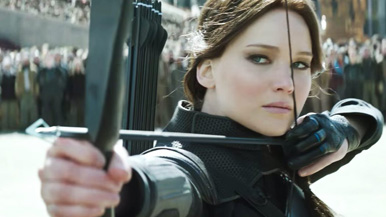Book vs. Movie - The Hunger Games: Mockingjay Part 2
By Ben Gruchow
November 28, 2016
This mood sticks through the remainder of Mockingjay’s back half, even through set pieces that are ostensibly there to make the reader feel some kind of empathy or warmth, such as a wedding between Finnick and Annie that contains almost as much prose detailing the bureaucratic review process the event goes through as text of the event itself. The passages of the book where Katniss and Johanna undergo their training regimen has moments of clarity, but it’s mostly going through the motions.
Even once we do get to the outer range of the city, the characters - and by extension, we as the audience - are in stasis as we go through Peeta’s reintroduction and the slow mixing of military action with propaganda. Thus mostly caps an odd chunk of the final novel in the series; what technically should be depicted in scenes of tension and momentum is instead approached with the mundane (and arguably more realistic) sense of wasted time and potential getting the right angle and framing on a significant act rather than any significant act actually being performed.
This comes to an abrupt end with the detonation of a land mine concealed in a paving stone and the gruesome death of a major character. The final plot point of this intended assault on the Capitol - that Katniss fakes a special mission from Coin to kill Snow - is established, and we cease receiving much explanation as the story morphs into halting passages of forward movement and character development, punctuated by sudden violence. Going through the pace and tone of this final run-up in the book, I was reminded of one of the many times that Stephen King broke into the narrative to directly address the reader of the final (underappreciated) book in his Dark Tower series. The first death of a major character in that book, too, triggered the book’s final cascade of events: “The story of their fellowship ends here,” King writes, “on this make-believe street and beneath this artificial sun; the rest of the tale will be short and brutal compared to all that’s gone before.”
So it is here. There are several further pods triggered and traps sprung on the group, and several more deaths, but none seem to really register to Katniss beyond a flicker of recognition and a flat, emotionless description of the event. Not until the tail end of the final action set piece - a massively-scaled riot in front of President Snow’s mansion, involving indiscriminate warfare, a pod the size of a city block, and a truly gruesome manipulation of human emotion that doesn’t lose much of its impact for how predictable it is - is the incident portrayed with much more than analytical detachment.
This is probably the only reason why the chain of events following this set piece, resolving story thread after story thread by a methodical and consistent rhythm, isn’t completely jarring; the procedural that follows the action component of the final part of the book would read as a brutal downshift in pace from anything that was perceptible as excitement, and it may have thrown off the resolution of the book’s theme entirely. Even as it is, this final stretch of events - involving the aftermath of the war, the settling of the Capitol, and a decisive end to the question of leadership and power-exchange with the District 13 administration - doesn’t really “work”; critical incidents are described to Katniss after they’ve occurred, which worked in the context of a suspense narrative and doesn’t work nearly as well in the tragic context of Mockingjay.
Continued:
1
2
3
4
5




